Star Trek: Who Are The Most Advanced Species?
Taking a deep dive into some of the most powerful races from the iconic science fiction franchise.
Star Trek has cemented itself over years as one of the cornerstones of science fiction in popular culture. New iterations into the franchise only add to its legacy. Alongside some incredible technology, some of which even changed the course of science today . The franchise's world-building is vibrant, and draws fans into the science fiction world.
The franchise features a plethora of wild and wacky aliens, all with their own unique designs, cultures, personalities, and beliefs. Some of these have been around as established space powers for longer than others. The Vulcans, for example, had a firm grasp over the galaxy before humans even managed to develop warp power . But of all these species that flesh out the Star Trek universe, who are the most advanced?
RELATED: Star Trek: The Next Generation - The Best Data Episodes

Godlike Powers
The first race that come to mind are the Q. This race of near omnipotent space ‘gods’ seem to have near limitless powers. They have been around and have evolved for centuries, their culture and way of life reaching the final stages of what’s possible. As the reoccurring face of the Q states, it makes for a very boring existence. The Q continuum barely even talk anymore, every conversation and word having been uttered a million times already. They possess incredible power, able to snap their fingers and wipe out entire universes. They can change the timeline at will and manipulate time and space like it means nothing. They pose an interesting question, however, about what the term ‘advanced’ actually means. While they arguably far ahead in their physical, mental, and technological development, they are arguably so advanced they exist entirely on another plane. Their presence within the world of Star Trek often amounts to fleeting journeys ( often to teach or torment Picard ), and they are thus hard to compare to other species within the grounded universe.
The Douwd , on the other hand, are a species that exists in the moment. They still exist on the same plane of existence as the rest, but they pose another problem with defining advancement. They are, excluding the Q, the most powerful of all species shown in the franchise. However, this does not equate to advancement, due to their on-screen inability to control their power. Being an advanced race suggests an ability to use and understand the intricate and complex inner workings of the power they harness. The Douwd are more akin to a normal human from the 21st century being given the powers of a god. What they can do with the power is immense, but it doesn't on its own denote advancement. The Douwd that audiences meet is able to wipe out an entire race of beings with just a thought, but likely unable to recite this later, unable to fully control his power.
The Douwd and the Q show Star Trek ’s ability to create god-like beings with powers akin to magic. Potentially more interesting, though, is the portrayal of races that have developed advanced technology. Gadgets and gizmos that define the sci-fi genre are at the heart of the franchise.
Advanced Technology
One race of beings who show the trajectory of how far technology can be taken are the mysterious Breen. They were first introduced in TNG as somewhat of a writer's joke, mentioned multiple times but never shown on screen. This all changed when DS9 came along, and audiences got their first glimpse of these masked beings. They are aggressive and isolationist, never mixing with other cultures by choice unless it’s to attack them. Their joining the Founders in the Dominion war was uncharacteristic, although they conducted themselves true to form: ruthlessly.
The Breen are some of the galaxy’s most formidable warriors, and the fact they are shrouded in a thick veil of mystery only adds to the fear they conjure up in others. Nothing is known about their home world or even what they look like under their armor. All that is widely known is that they possess technology that can disable any ship with ease. Their shields and weapons are so advanced that nothing can stand a chance. The mighty Klingon empire , a race known for their battle power and their tact in war, couldn't even defeat them. They sent an entire fleet of ships into their territory only to have none of them return. There was not even a single transmission to inform others of their fate.
The Slavers are an honorable mention, as they originate outside official canon. It’s hard to talk about an advanced race that is long extinct, as the Slaver empire existed about a billion years ago. First mentioned in The Animated Series , it’s revealed that they were so advanced they had conquered the entire galaxy in a war ended up eradicating literally all life in the universe, even down to the smallest of microbes. Their power was so advanced that life had to re-evolve to get to where it is today. The only trace of their existence was stasis boxes containing clues and artifacts, one of which Kirk and his crew discover. Inside is a small, handheld weapon that contains incredible power despite its size. Sulu causes an explosion upon firing, and Spock says that it is more powerful than any weapon known to the Federation. It’s a staggering statement considering how small the weapon was, akin to a phaser . The technology contained within it far surpassed anything shown previously and since in the Star Trek universe.
MORE: Star Trek: What Was Founder's Disease?

- View history
The Voth were an ancient Saurian species located in the Delta Quadrant . They were originally native to Earth , with the dinosaur genus hadrosaurs fingered as a likely ancestor. A significantly advanced species, the Voth were cold-blooded creatures , had a superior sense of smell, and skin pigmentation which altered according to moods. ( VOY : " Distant Origin ")
- 2 Physiology
- 3 Society and philosophy
- 4 Technology
- 6.1 See also
- 6.2 Appearances
- 6.3 Background information
- 6.4 Apocrypha
- 6.5 External link
History [ ]
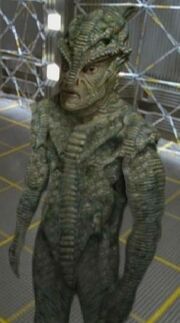
A possible extrapolated descendant of the hadrosaur
Although this was not corroborated with archeological evidence, genetic evidence strongly suggested that the Voth originated on Earth – a concept later referred to as " Distant Origin Theory ". It was speculated by The Doctor that they evolved from the hadrosaur genus , which might have survived the mass extinction at the end of the Cretaceous 65 million years ago . The surviving dinosaurs continued to develop, likely on a secluded, or a destroyed landmass and became an interstellar species, possibly the first in the galaxy , when they left Earth. According to Human Commander Chakotay , because " Earth has been devastated by countless natural disasters over the course of its history : asteroids , volcanoes , earthquakes . All evidence of your race could be at the bottom of the ocean or under kilometers of rock . "
The species ultimately ended up in the Delta Quadrant , where they claimed a domain, laid the foundation of what became the great Voth culture, and forgot their origins. The recorded history and identity of the Voth began about 20 million years ago , at which point they already considered themselves a race indigenous to the Delta Quadrant. ( VOY : " Friendship One ") By the 24th century , they had in fact believed for millions of years to be the first intelligent race to evolve in their region of space. By this period, Earth and Humanity were beyond their known space.
Throughout a significant portion of Voth history, technological and cultural progression has been stunted, and even stagnant at times. The Ancient Doctrine, which forms the basis of Voth societal structure, predicted that such advanced technologies as transwarp would cause terrible disasters if it were even attempted, resulting in their civilization to be held back for millennia. However, eventually someone took a chance and Voth society entered a new chapter of exploration, with Doctrine being altered accordingly to better suit the new cultural paradigm in their society.
During the 24th century , the Distant Origin Theory started gaining traction among the Circles of Science and Philosophy , as well as among common Voth citizens in noticeable amounts. However, the Ministry of Elders viewed the theory as a threat to established Doctrine, and by extension the authority granted to them by it. Forra Gegen found conclusive evidence in 2373 , causing the Ministry of Elders to raise charges against him for Heresy Against Doctrine, as well as impound the Voyager starship with all its crew aboard, who were meant to serve as Gegen's most significant evidence in favor of his theory. Scientists were brought in, sometimes under significant political pressure, to offer the alternative analysis that although Gegen's data was generally sound, his conclusions were wrong. Odala , as a representative of the Elders, was reluctant to punish Gegen as such, but were more concerned about getting him to retract his claims.
Odala went as far as to declare that if she accepted this theory, she would be admitting her race had fled in terror from Earth, scratching and clawing their way to the part of space where the Voth now lived on a city ship , that her race had no birthright, no legacy – the concept appalled and disgusted her. Chakotay attempted to persuade her that surviving among some of the fiercest creatures in Earth's history, creating a culture, language and technology, leaving Earth when it faced peril and going into space, and journeying to the Delta Quadrant to start a new life was the definition of the Voth ancestors, the struggle that made the race who they were – was their heritage, and to dismiss the sacrifice their ancestors made to save themselves and future generations would be to dishonor them.
It was not enough; the Ministry of Elders convicted Gegen of heresy , and threatened to imprison him and the crew of the Voyager on a prison colony . Unwilling to allow such a sentence to weigh on his conscience, Gegen chose to retract his claims and absolved the crew of any involvement in his theory. ( VOY : " Distant Origin ")
Physiology [ ]

Adult Voth were slightly taller than adult Humans and had three clawed, manipulatory digits on each hand. Their eyes were protected by heavy, bony brow ridges, which had a central crest rising to a conical protrusion on the back of the skull . Their coloration varied from green to brown to a brownish orange, even between close relatives. Infatuation might be indicated by a change in the tint of the scales. Their language appeared click-like.
Cranial capacity of a Human was twenty-two percent smaller than that of a Voth. A long tongue allowed the feeding on airborne insects .
Most importantly, they had forty-seven genetic markers that were identical to Humans and many Terran creatures throughout Earth's history .
The Voth were capable of entering into hibernative states to protect themselves from harm. Their superior sense of smell was achieved through the dilitus lobe , and allowed them to enjoy the sulfur lagoons of Hokath . The Voth were also able to fire spikes from an area on the lower arm, which had a paralytic effect. ( VOY : " Distant Origin ")
Society and philosophy [ ]
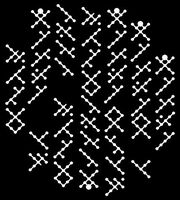
Voth script
The Voth were governed by a Ministry of Elders . They lived in family structures, which might be bound to always mate with another family by tradition. Scientists and philosophers were organized in academic circles , which were entered into in a process which involved the giving out of honors. They had very poor relations with non-saurian races, and mammals , in particular, were considered to be lower life forms.
At the heart of their society lay their Doctrine , their guiding principles. Despite intuition and passion being valued, doctrine loomed heavily. They specified that the Voth had been the first intelligent beings to evolve in their region of space, and had an "ancient and rightful claim" over it. In addition, it declared that non-indigenous beings had no rights. Interrogation surgeons might be employed against them. Heresy against Doctrine was an arrestable and serious offense. Detention colonies were also employed by the Voth government.
An expression in their language talked about someone's "true scales" being shown.
Technology [ ]
As a society many millions of years old, the Voth were technologically advanced, possessed transwarp capabilities, as well as an even more advanced space travel technology called spatial displacement , which functionally doubled as a highly advanced cloaking device as it moved their starships or even individuals slightly out of phase with the space-time continuum. Their personal spatial displacement system could be disrupted by altering a phaser to a dispersion frequency of approximately 1.85 GHz .
They were able to scan from a distance of over ninety light years with significant accuracy, even down to the individual lifeform readings. The Voth were also able to take command of a ship's computer , shut the majority of systems down, and take primary power offline. What appeared to be a dampening field was capable of rendering tricorders , communicators , and phasers useless.
The Voth city ship was massive and extremely powerful in comparison with Starfleet spacecraft . They could beam a mass as big as 700,000 metric tons into a large internal chamber big enough for many starships. A ship might be transported in this way even if their shields were raised. ( VOY : " Distant Origin ")
- Frola Gegen
- Forra Gegen
- Unnamed Voth
Appendices [ ]
See also [ ], appearances [ ].
- VOY : " Distant Origin "
Background information [ ]
The Voth resemble, both conceptually and visually, the Silurian race from Doctor Who , in which the Silurians, like the Voth, are an advanced reptile species who have evolved on Earth before Humanity and have subsequently disappeared. In addition, both Doctor Who and the Silurians and "Distant Origin" use a small, hand-held globe of prehistoric Earth as a plot point. There is also a strong physical resemblance between the costumes and make-up used for the two alien races.
The idea of a humanoid evolving from a dinosaur has occasionally been discussed in scientific circles from the seventies onward, most famously with Dale Russell's dinosauroid. Carl Sagan also speculated on the possibility. See the external links below for more info.
Of interest is whether the Voth are cold-blooded due to evolutionary changes after leaving Earth or if their being cold-blooded is merely an error in the scripting research as dinosaurs, while reptile-like, were not cold-blooded.
Apocrypha [ ]
The Voth made a brief appearance in the short story "Brief Candle" in the Distant Shores anthology. They are also mentioned in the Star Trek: Strange New Worlds novels as a possible candidate to combat the Borg by the Q .
A similar storyline was found in the First Frontier novel, which has a race known as Clan Ru, who are evolved from Troodons.
The Voth appear in two novels of the Star Trek: Voyager relaunch series by Pocket Books : Protectors and Acts of Contrition . In those stories, they ally themselves with the Devore , Turei , and Vaadwaur . They are opposed to the Confederacy of the Worlds of the First Quadrant, a Delta Quadrant counterpart to the Federation .
The Voth appear in the Star Trek Online video game as an antagonistic faction, fighting for control of a Dyson sphere located in the Delta Quadrant, and against the allied forces of the Federation, Klingon Empire , and Romulan Republic. The Voth are attempting to obtain Omega particles , which the sphere produces, as a weapon against the Borg, whom they are battling in their home space. The allied forces, who entered the sphere via an Iconian gateway near Jouret IV , are attempting to enforce the Omega Directive and prevent the Voth from making off with Omega and potentially threatening spacefaring civilizations in the Delta Quadrant and beyond. The Voth who appear in the game are part of an aggressive, militaristic circle of Voth society, and use city ships in their combat fleets. Mechanized combat exosuits and bio-engineered dinosaurs also make up part of their ground forces. In STO 's 2014 Delta Rising expansion, the Voth are allies of the Turei and fight to defend them against a Vaadwaur invasion in the mission "Revelations", allying with the player in a ground battle. Additionally, in the space patrol "Tempting Targets", the player allies with Voth ships, escorting Turei, Hazari and Talaxian ships inbound to a trade station, defending them against Vaaduaur, Malon and Hirogen ships, with the hostiles chosen at random. However, they remain aloof from subsequently joining the Delta Alliance.
External link [ ]
- Voth at Memory Beta , the wiki for licensed Star Trek works
- Speculations of anthropomorphic sapient dinosaurs at Wikipedia
- a short overview of the history of hypothetical humanoid dinosaurs in science
Which Species Is the Smartest In Star Trek?
From Vulcans to Klingons to the Borg, Gene Roddenberry's universe is full of intelligent beings. But which is the smartest being in all of Star Trek?
Quick Links
The vulcans are smart but prisoners to logic in star trek, the borg is the star trek species with the most accumulated knowledge, are non-corporeal beings star trek's smartest alien lifeforms, androids and synthetic life forms are star trek's most intelligent.
There are many reasons people find Gene Roddenberry's vision of the future a little hard to believe. The main one is that humanity transcends its petty bigotries, fears and tribalism to become a united Earth committed to the goal of peaceful exploration and scientific advancement. While humans are integral to the United Federation of Planets, they aren't, technically, the smartest alien species in Star Trek . There are many contenders, but it all depends on how one defines intelligence.
In Star Trek: The Original Series , the alien societies the crew of the USS Enterprise encountered would sometimes be less advanced than humanity. In other episodes, such as Season 1's "Errand of Mercy," the Organians are more intelligent and powerful than the Federation or the Klingons. In the second wave of the franchise, humanity and the Federation are often portrayed as the more advanced civilization, in part because of "the Roddenberry box" writers were put into. If an alien species had greater knowledge or technological prowess, then the Federation -- usually humans -- were typically the morally superior group. With all the intelligent alien races that have been introduced throughout Star Trek , it begs the question of which is truly the smartest of them all.
Star Trek: Humanity Was a Vulcan Pet Project for Centuries
During the conception of The Original Series , the Vulcans were meant to be one of the most intelligent species in the galaxy. Specifically, the USS Enterprise Science Officer, Mr. Spock, is the resident know-it-all on the ship. He is usually the member of the crew to figure out whatever scientific problem ailed the ship. He's also often vaguely aware of rare or new species or phenomena. Yet, the other Vulcans seen in The Original Series are not so well-equipped. In Season 2's "Amok Time" and "Journey to Babel," the other Vulcans are depicted as rigid and cold, despite their commitment to logic.
The next show to feature a regular Vulcan character was Star Trek: Voyager , with Commander Tuvok. However, instead of being the ship's science officer, he was the chief of security. As intellect goes, he was always knowledgeable and capable. Yet, he wasn't the smartest character in the show, especially once Seven of Nine showed up. Even Ensign Harry Kim seemed more science-minded since he helped construct the Astrometrics lab. While Vulcans have a very high level of intelligence, not all of them are as smart as Spock .
Successive series -- from Star Trek: Enterprise to Star Trek: Discovery -- have continued to include Vulcan characters and reveal more about their society. Most are committed to logic, which is not quite the same thing as being smart. Star Trek: Picard introduced a Vulcan crime lord , who was able to use logic to justify his actions. There are many ways that humans or other species display similar or greater intelligence than Vulcans. This is because in Star Trek , one's intellect is determined by their willingness to learn rather than whether their blood is green or red.
Star Trek Theory: Why the Borg Queen Didn't Appear in The Next Generation
Originally created by Maurice Hurley, the Borg , were introduced in Star Trek: The Next Generation Season 2. In that first episode, the Borg were still all about assimilation, yet they were unconcerned with the crew of the USS Enterprise-D . Instead, they were more interested in assimilating the technology of the Federation. Once the series introduced the idea of the Borg assimilating living beings, the accumulated knowledge they possessed increased. Not only did they assimilate the technology of other species, but they also assimilated the people as well.
This means the Borg not only learned how Starfleet transporters worked, but they also acquired the knowledge of the people they assimilated. Former drone Seven of Nine , for example, was able to recall details about species and cultures in the Delta Quadrant off-the-top of her head. Yet, the Borg didn't seem to retain information they thought was unnecessary. Knowledge of art, literature and the interpersonal details of people were likely seen as junk data and discarded. Still, having identified and assimilated thousands of species across the galaxy, the Borg knew more than probably every other individual Star Trek civilization combined.
What makes the Borg evil beyond their conquest to add others' distinctiveness to their own is what they do with their knowledge. The Borg accumulate their knowledge and don't share it with other species or cultures. When Admiral Kathryn Janeway struck the death blow to the Borg, and then the refurbished USS Enterprise-D crew finished them off, their knowledge died with them. While the Borg may have had the most knowledge, it isn't accurate to call them the smartest species.
Star Trek: Prodigy Cast and Character Guide
Intellect is usually tied to technological advancement, especially in Star Trek stories. Starfleet's Prime Directive order showcases this. Their officers aren't allowed to contact a species unless they've developed warp engine capabilities. However, many of the smartest species in Star Trek don't use technology at all. The Bajoran prophets from Deep Space Nine were noncorporeal lifeforms who also transcended linear time. Yet, this prevented them from sharing their knowledge with the corporeal Bajorans, thus the need for Captain Sisko to become their Emissary.
Without the need for physical form, the Bajorans and other species seem to be magic. This appears to be consistent with the famous Third Law from Arthur C. Clarke's Profiles of the Future , which states that "any sufficiently advanced technology is indistinguishable from magic." This makes sense. Travel back 10,000 years into the past with a lighter, and the people living in that time would think the lighter was a magic wand. While it seems like the Bajoran prophets, the Organians or the members of the Q Continuum can "do magic," it's likely just an advanced form of technology.
The Metrons -- another incorporeal species from Star Trek: The Original Series' Season 1 episode "Arena" -- were able to incapacitate the Enterprise with what seemed like a thought. In Season 2's "Who Mourns for Adonis," the god Apollo is able to manifest a large green hand that literally catches the ship in space. These abilities and being unbound by time, means these beings are like the smartest aliens in the Star Trek universe. They are able to transcend the laws of physics and seemingly perform miracles. However, similar to the Borg, they are often unable to share this knowledge.
Does Star Trek's Data Come from a Family of Monsters?
If a being's knowledge is only worth what can be shared, then artificial lifeforms may be the smartest being in Star Trek . Naturally, Commander Data comes immediately to mind . With his "positronic brain," he is both sentient, autonomous, capable of learning and, more importantly, eager to share this knowledge with others. From Data's introduction in Star Trek: The Next Generation to the final moments of Picard , his quest wasn't to gain more data, but rather to crack the mystery of humanity.
Before he ever got his "emotion chip," Data was able to learn and apply those lessons he learned. Any gamer who tried to install Call of Duty: Black Ops Cold War knows that any storage device has its limits. However, synthetic lifeforms like Data don't seem to ever fill up their hard drives. They are able to constantly process and store new input, while still able to recall letter-perfect details of what they've read and studied. Synthetic lifeforms' only limits seem to be the information they have access to.
Like the Vulcans, Data and synthetics follow a computer-like system of logic. Similar to the Borg, they are able to assimilate data from many sources and retain it. Synths like Data or Soji from Picard are also able to do things that seem like magic, though they retain their corporeal form. Since one of the main tenets of Star Trek isn't just the acquisition of knowledge but sharing it, androids and other sentient computers are likely the smartest beings out there. Some -- like Star Trek: Prodigy 's Hologram Janeway or the Doctor -- don't know everything like Data. However, when they have no limit to what they can learn, there is also no limit to what they can teach.
The Star Trek universe encompasses multiple series, each offering a unique lens through which to experience the wonders and perils of space travel. Join Captain Kirk and his crew on the Original Series' voyages of discovery, encounter the utopian vision of the Federation in The Next Generation, or delve into the darker corners of galactic politics in Deep Space Nine. No matter your preference, there's a Star Trek adventure waiting to ignite your imagination.
'Star Trek: The Original Series': The 10 Most Powerful Characters, Ranked
Power comes in all shapes and forms.
Recently in Star Trek: Strange New Worlds , Spock ( Ethan Peck ) and James Kirk ( Paul Wesley ) had their historic first meeting . Such a momentous occasion makes it a good time to look back at some of the classic adventures William Shatner and Leonard Nimoy had in Star Trek: The Original Series .
The crew of the Enterprise often tangled with super-powered beings far beyond any human understanding. Some might think of themselves as gods, others just advanced aliens, not to mention a surprising number of super kids.
Featured in "The Changeling," Nomad was a space probe created to be the perfect thinking machine. It made it a mission to destroy what it found to be imperfect. This included an entire star system-- and its four billion inhabitants-- before turning its attention onto the Enterprise.
Related: 'Star Trek': The 10 Main Captains, Ranked
While Trek featured many advanced computers, his impressive body count made Nomad stand out. Aside from the star system it wiped out, Nomad killed and resurrected Scotty ( James Doohan ) and permanently wiped the memory of Uhura ( Nichelle Nichols )
9 Guardian of Forever
Created by Harlan Ellison , The Guardian of Forever first appeared in "City on the Edge of Forever." The talking archway could transport people to any time or place. It sends Kirk, Spock and McCoy ( DeForest Kelley ) to New York City in the 1930s, where Kirk falls in love with Edith Keeler ( Joan Collins ), a woman who must die to stop America from losing World War II.
In its first appearance, the Guardian was a powerful but mysterious entity. In Star Trek: Discovery , it was established as a sentient being ( Paul Guilfoyle ) capable of sending Phillipa Georgiou ( Michelle Yeoh ) not only to the past but into the Mirror Universe .
8 The Platonians
Among the most sinister of Kirk's foes were the Platonians from "Plato's Stepchildren." While their machinations did create a historic moment-- one of the first interracial kisses on television-- it was done under the duress of Kirk and Uhura. The Platonians had the power to control people mentally and they used this for their amusement against Kirk and his crew. This included the monumental kiss between Kirk and Uhura and making Kirk threaten his crew.
Related: The 10 Most Underrated 'Star Trek: The Next Generation' Episodes
The Platonians are horrific decadence, using their powers to make people do things against their will and gain amusement from the discomfort. While they are mighty, they are truly despicable.

7 The Talosians
The original advanced aliens, The Talosians, were the first aliens to appear in Trek , in the pilot "The Cage." They would not make their canonical debut until the two-part "The Menagerie." The Talosians possessed amazing mental abilities, including perfect illusions that could grant health to a grievously injured person. Captain Pike ( Jeffrey Hunter ) dealt with the Talosians wanting to keep him in their menagerie.
The powers of the Talosians were considered so great by the Federation that travel to Talos IV held a death sentence. Spock risked this to bring Pike there after Pike was exposed to delta radiation.
6 The Metrons
The Metrons were responsible for one of the most iconic moments in Trek : the battle between Kirk and the Gorn in "Arena." The highly advanced aliens could draw the Enterprise and the Gorn ship to them using their mental abilities. They then transported Kirk and the Gorn Captain to a planet to fight to the death.
Only when Kirk wins his battle with the Gorn but refuses to kill him does the Metrons reveal themselves. Deciding both species were more advanced than they'd thought, the Metrons spared both.
The image of Apollo's ( Michael Forest ) gigantic green hand reaching out and grabbing the Enterprise is memorable. Apollo claimed to be the source of the Greek myth, having lived for thousands of years. He was the last remaining of the pantheon.
Related: From 'Star Trek' to 'The Mandalorian': 10 Iconic Shows Set in Space
Apollo's downfall would come from his wish to keep the Enterprise crew- particularly Lt. Palamas ( Leslie Parrish )- with him. To escape, the Enterprise destroyed Apollo's temple. Rejected by Palamas and with his powers diminished, Apollo chose to disperse himself into the wind.
4 Organians
It would take a powerful species to foster peace between the Federation and the Klingons. This is the case with the Organians in "Errand of Mercy." With the two opposing factions on the brink of war, the Organians used their powers to disarm both fleets, forcing Kirk to negotiate with Kor ( John Colicos ) on the Treaty of Organia,
As incorporeal beings of pure thought and energy, the Organians were immortal with incredible mental powers. Their later appearance in Star Trek: Enterprise episode "Observer Effect" showed them resurrecting the dead and erasing memories.
3 Charlie Evans
Charlie Evans ( Robert Walker ) would be just as home in an episode of The Twilight Zone as he was in "Charlie X." an average human granted powers by the Thasians to survive on the harsh world of their home planet. Unfortunately, as a teenage boy, Charlie cannot control his emotions and lacks socialization due to growing up alone. He uses his power to pursue Yeoman Rand ( Grace Lee Whitney ), who he'd fallen in love with.
Related: The 10 Most Powerful Characters in 'The Mandalorian', Ranked
Charlie was able to use telepathy and telekinesis. He could also create and destroy matter. His volatile teenage emotions made these powers seem even more impressive, as he used them without thought.
2 Gary Mitchell
Coming up through Starfleet Academy, Gary Mitchell ( Gary Lockwood ) and Kirk were best friends. That was until "Where No Man Has Gone Before," when the Enterprise went through the Galactic Barrier and Mitchell was infected by what Star Trek: Lower Decks would later call "strange energies." He became silver-eyed and possessed a tremendous range of mental abilities, including telepathy, telekinesis, clairvoyance and invulnerability to phasers.
Related: 11 Sci-Fi Shows to Binge If You Love ‘Star Trek’
Power corrupts and this was the case with Mitchell. He became cruel to his fellow crew members, thinking he was above them due to his abilities. Despite Mitchell's powers, he was prone to errors, writing a gravestone for Kirk that read "James R. Kirk," while Kirk's middle name is famously Tiberius.
The eponymous character from "The Squire of Gothos," Trelane (William Campbell) kidnapped members of the Enterprise crew for his enjoyment. He was part of a reality-warping species beyond the comprehension of humans. His immature and irresponsible use of powers is because he is immature and irresponsible, a child member of his race, with Gothos being essentially a playpen for him.
Trelane's puckish but dangerous attitude with Kirk resembles Captain Picard's ( Patrick Stewart ) interactions with Q ( John DeLancie ). Several Trek books have retroactively made Trelane a member of the Q Continuum, while Mariner ( Tawny Newsome ) in the Strange New Worlds/Lower Decks crossover reminded Boimler that the crew of the original 1701 has "kind of a Trelane thing going on" rather than Q.
Next: 'Star Trek: Strange New Worlds' Characters, Ranked by Likability
- More to Explore
- Series & Movies
Published Jul 2, 2023
Star Trek's One-Hit Wonder Alien Species, Ranked
We may have only seen them once, but they made the most of their limited time.
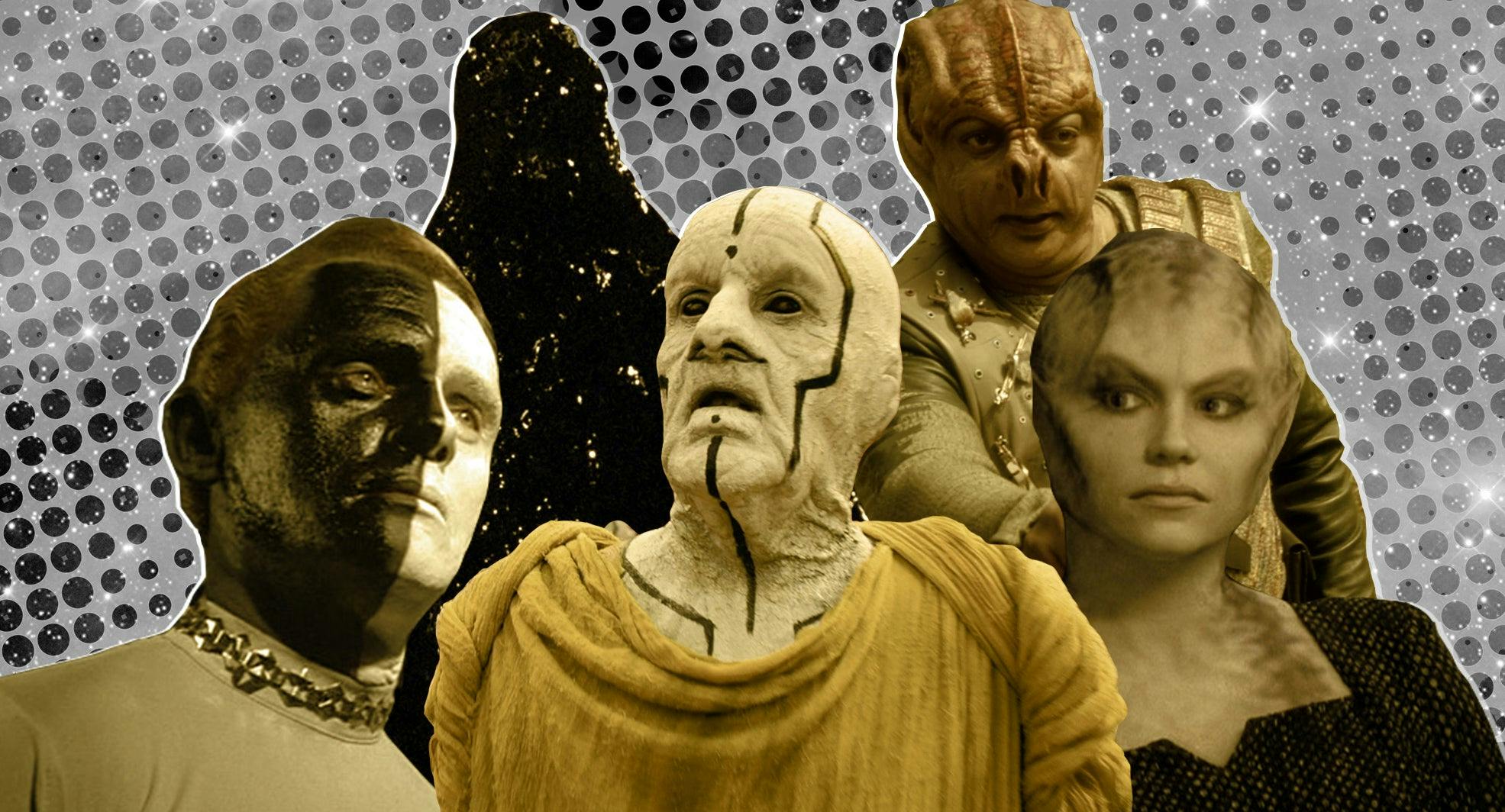
StarTrek.com
When it comes to Star Trek aliens, the Klingons are as ubiquitous as the Beatles, while the Ferengi are more of “Top 40” choice, the Andorians are like an indie band, and the Romulans are whatever type of music you hate the most.
But what about the one-hit wonder alien races — the species that only appeared in one episode (or movie), but who we still think about all the time? Some looked unique, others communicated or reproduced differently, and many taught us important lessons about our own humanity. Here are some of our favorite one-hit wonder species.
10. The Nibirans
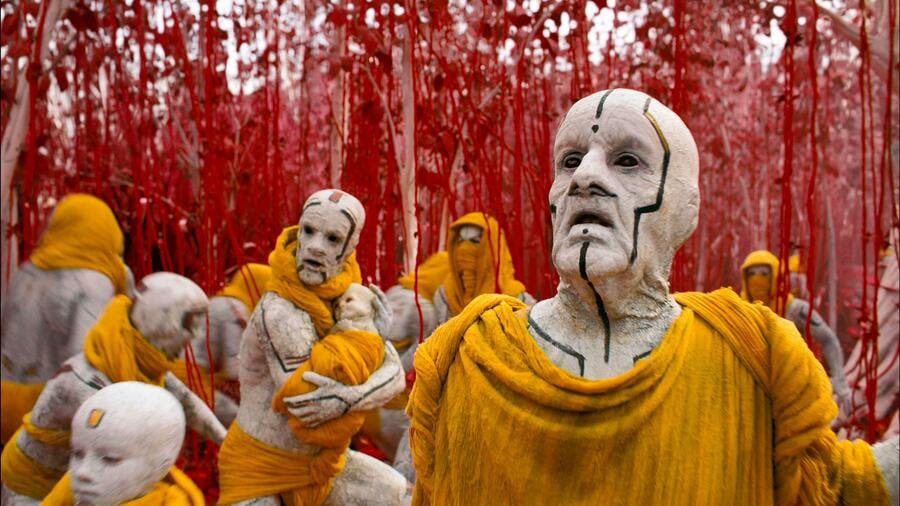
What happens when you disobey the Prime Directive? The Nibirans — aka, the species seen chasing down Kirk and McCoy in the opening of Star Trek Into Darkness — give us a possible answer. After getting a good look at the Enterprise , the primitive race sets aside their sacred scroll to draw pictures of the starship instead. Kirk gets demoted for “playing god” and you have to wonder how things changed on the planet Nibiru after that. Was an Enterprise shrine built inside the volcano Spock kept from blowing up?
9. The Kradin
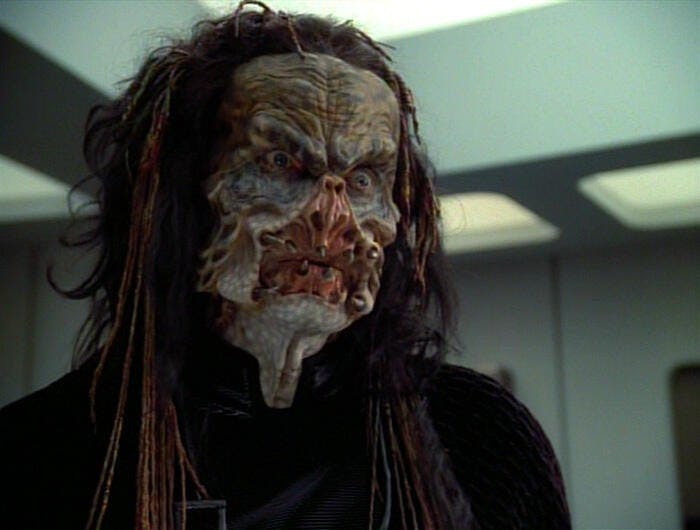
When Chakotay’s shuttlecraft crash-lands on an unknown planet in Star Trek: Voyager 's " Nemesis ," he’s taken in by a group of earnest, plucky rebels fighting an unjust war against a murderous race called the Kradin. Chakotay sees the monstrous-looking Kradin abducting elderly villagers, harassing children, and killing his comrades — but it turns out it’s all a holosimulation designed to recruit fighters from the crews of passing ships. The Kradin are actually the good guys! But even after finding out the truth, Chakotay discovers that he still doesn’t want to be in the same room as one. “I wish it was as easy to stop hating as it is to start,” he tells Janeway.
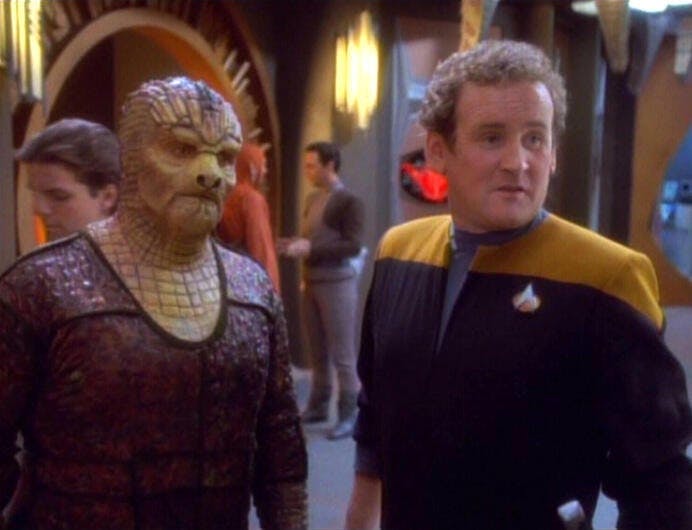
When dealing with a shy, nervous race, send in the Irish guy. That seems to be Sisko’s thinking when he asks Chief O’Brien to befriend an alien whose ship he’s fixing in Star Trek: Deep Space Nine 's " Captive Pursuit ." O’Brien suspects he’s on the run, but he and the rest of the crew can’t get him to tell them what he’s running from. The riddle is solved when a hunter shows up, looking for his “prey.” Turns out, his species breeds Tosk to hunt them down, yet consider them sacred. The Tosk in their custody refuses asylum to avoid dishonor, so O’Brien helps him escape to live another day trying to evade the hunters.
7. The Tamarians
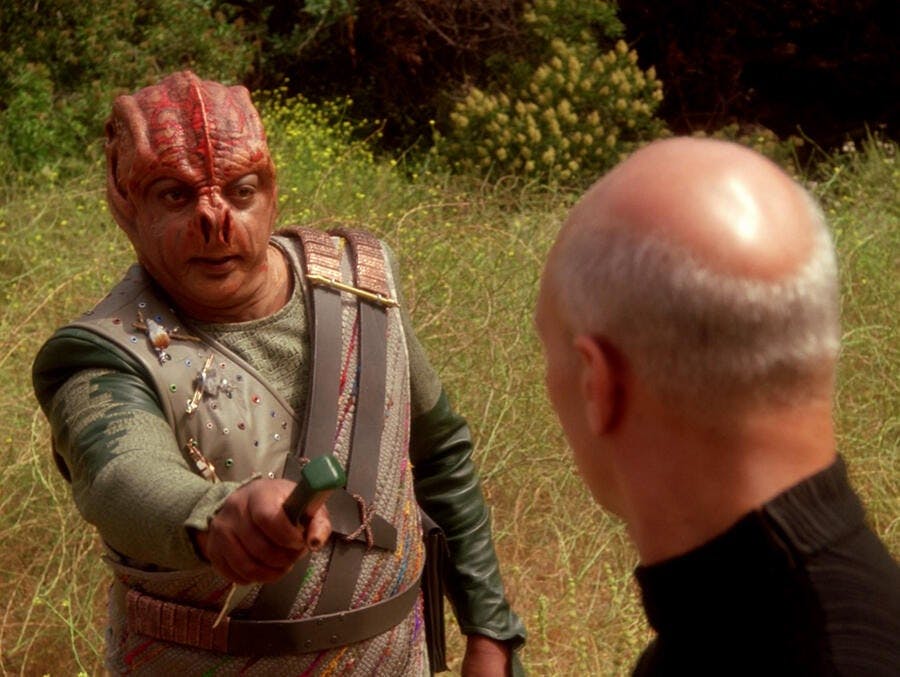
Shaka, when the walls fell!
If these words mean anything to you, you’re a fan of the memorable Star Trek: The Next Generation episode “ Darmok ,” which finds Picard stranded on a planet with a starship captain from a race known as the Children of Tama . Although his fellow maroon-ee seems relatively friendly, they can’t communicate, despite Picard’s universal translator. But literally no one is worried that Picard might not live up to the challenge. He figures out that the Tamarians speak in allegory, and learns what all the important ones mean in less time than you can say “Darmok and Jalad on the ocean.”
6. The Horta
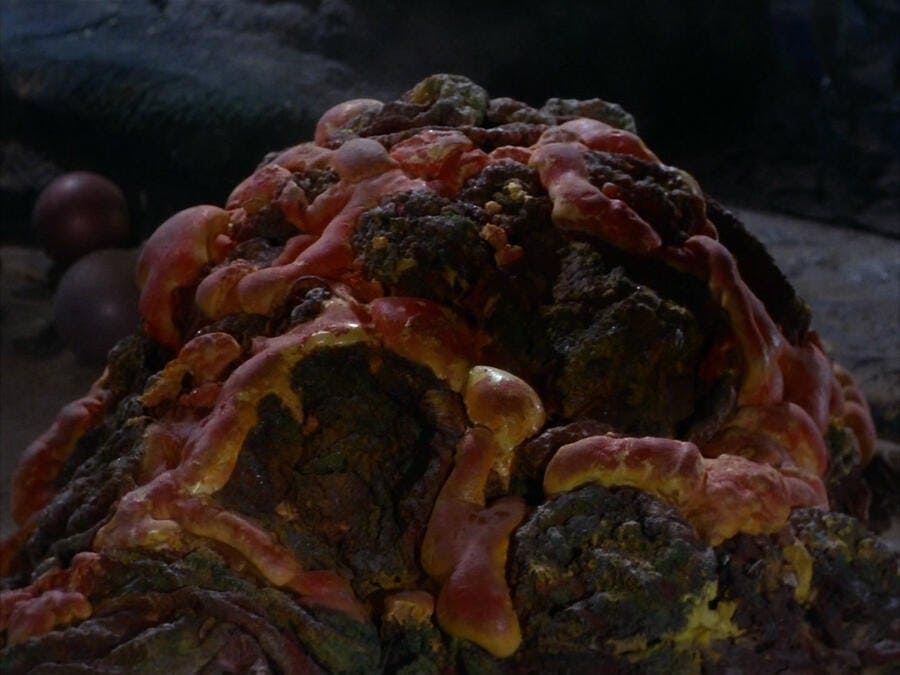
The first silicon-based lifeform to be introduced in the Star Trek universe, the Horta might prompt you to utter, “I’m a doctor, not a bricklayer!" That is, of course, if you’re Dr. McCoy and have been sent to nurse the rocky-looking creature in The Original Series episode, " The Devil in the Dark ." Spock, on the other hand, performs a mind-meld and finds he quite likes the alien, who admires his ears. IRL, the unique-looking creature was the brainchild of Janos Prohaska, who originally created it for The Outer Limits , where it appears as a giant germ. According to Inside Star Trek: The Real Story , he added some fringe and veins to transform it into a miner’s worst nightmare on Star Trek .
5. The Kobali
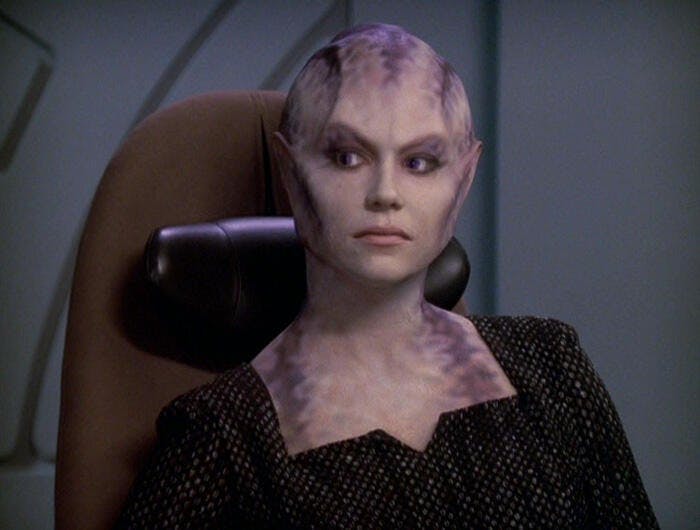
How would a humanoid species reproduce, if not sexually? An interesting answer to this question is given in the Voyager episode “ Ashes to Ashes ,” which features the Kobali, a species that salvages dead bodies and implants them with a genetic pathogen. The pathogen causes their DNA to change and their bodies to reanimate. In the process, their memories are wiped — except for the few who still remember who they were the first time they were alive. One such Kobali is Jhet'leya, aka Ensign Lyndsay Ballard , who died on an away mission. When she shows up at Voyager in her now-altered form, more goes wrong than she expects — and that doesn’t even include hooking up with Harry Kim.
4. The Gormagander
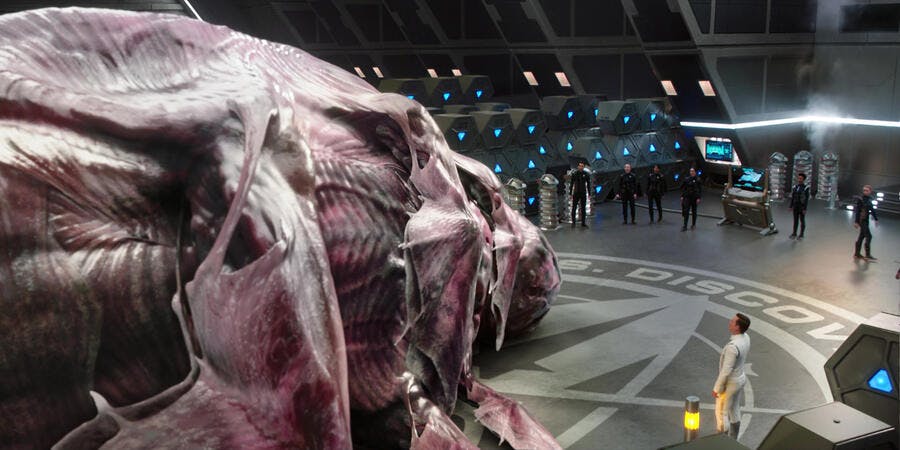
If you love marine life, you can’t help but squee a little when the Gormagander makes his appearance in Star Trek: Discovery 's " Magic to Make the Sanest Man Go Mad ." Also known as a space whale, these endangered creatures just float around space, chilling. When the Discovery crew encounters one, it seems injured; they beam it aboard to take it to a wildlife sanctuary.
A good idea until they find out that the Gormagander is actually experiencing its own personal Jonah-and-the-whale situation. Hiding inside is the infamous Harvey Mudd, who’s later brought up on charges for “penetrating a space whale” (among many other things) in The Original Series.
3. The Flying Parasites
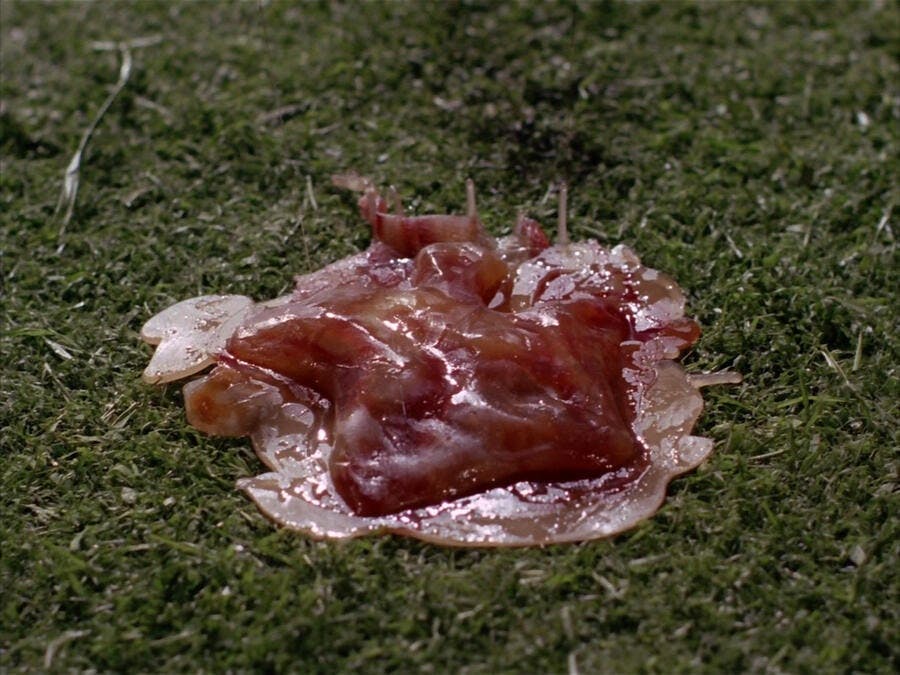
They were never really given a name, but don’t let that fool you — you do not want to run into the flying parasites that the Enterprise encounters on Deneva in " Operation: Annihilate! "
They sting, they know how to fly, they’re resistant to phasers — oh, and they made Kirk’s brother Sam go insane, then murdered him. These nightmare-inducing aliens, which look sort of like rubber placentas, are still no match for Spock, however. Although one latches onto his back, he overcomes the pain and the brainwashing, kidnaps one of the parasites to study, then has McCoy test out Kirk’s theory as to how to kill it. The procedure successfully releases him from the creature’s grasp, and even blindness can’t keep Spock down — thanks to his inner eyelids, the side effect is only temporary.
2. The Cheron
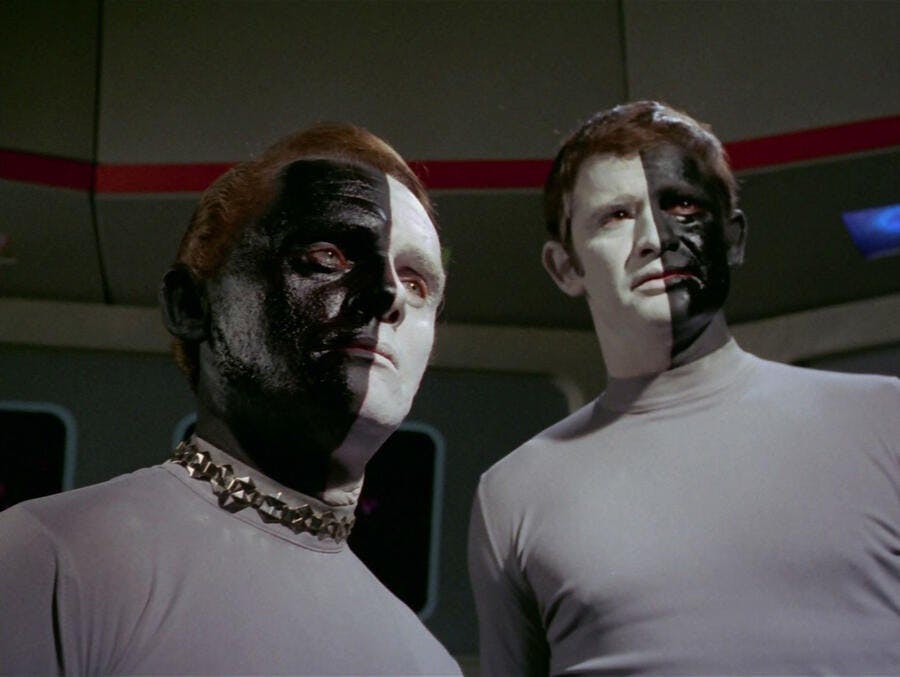
When the Enterprise encounters a comatose member of a new alien species from a planet that’s recently been destroyed, the fact that he has some organs Dr. McCoy has never seen is hardly the most notable thing about him. His skin is dark black on one side, and bright white on the other, leading McCoy and crew to decide he’s probably a mutant. But when they pick up a second survivor named Bele , he too has the unique pigmentation. There’s one problem — the two men hate each other.
In an unexpected twist, Bele (played by Frank Goshin, two years after portraying The Riddler in Batman ), explains to Kirk that the reason is obvious — he’s black on his right side, while the other Cheron is white on his right side. The episode " Let That Be Your Last Battlefield " is such a powerful allegory for racism that it stuck with a generation of fans who had only seen it on television one time.
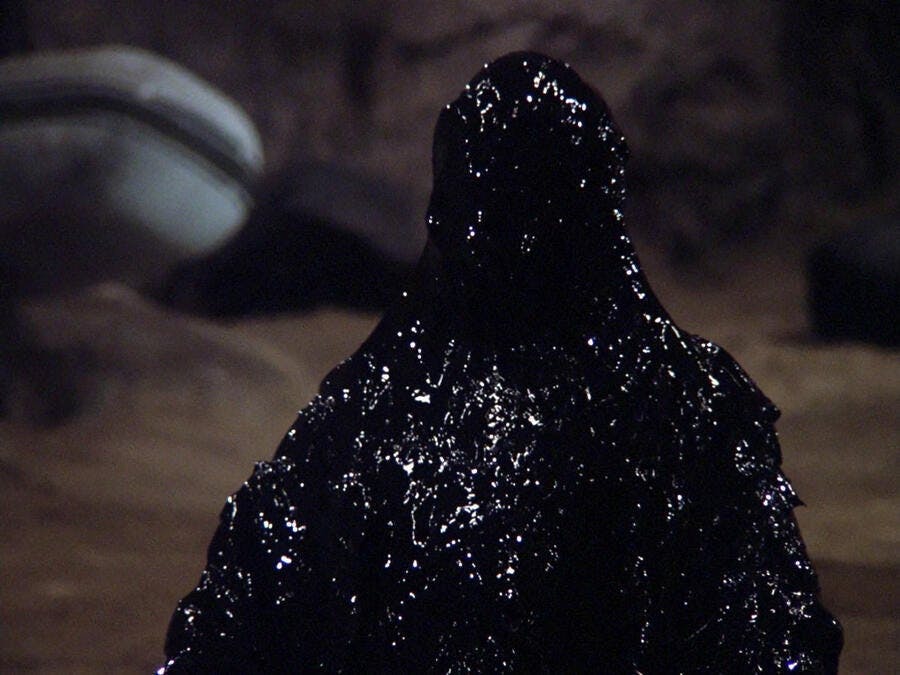
What does pure evil look like? If you said “a sentient pool of tar,” from " Skin of Evil ," then you know why The Next Generation ’s Armus is number one on this list.
Literally a discarded second skin of everything “evil and negative within” from another race who abandoned it on a desolate planet, Armus displays his sinister intentions immediately by senselessly murdering Tasha Yar. Picard is ultimately able to distract him with his dazzling intellect (and some poetry) long enough to get the rest of his crew off the surface, but the act of killing Yar has repercussions that reverberate throughout the rest of the series.
This article was originally published on August 12, 2019.
Get Updates By Email
Stay tuned to StarTrek.com for more details! And be sure to follow @StarTrek on Facebook , Twitter , and Instagram .
Jennifer Boudinot (she/her) is a freelance writer whose work has appeared on Collider, The Belladonna Comedy, and Points in Case. She's also the co-author of the books Dangerous Cocktails and Viva Mezcal. She lives in Brooklyn, New York, and is a Kira with a hint of Dax. Find her on Twitter @jenboudinot.
Star Trek: Discovery Seasons 1-4 are streaming exclusively on Paramount+ in the U.S., the UK, Canada, Switzerland, South Korea, Latin America, Germany, France, Italy, Australia and Austria. Seasons 2 and 3 also are available on the Pluto TV “Star Trek” channel in Switzerland, Germany and Austria. The series streams on Super Drama in Japan, TVNZ in New Zealand, and SkyShowtime in Spain, Portugal, Poland, The Nordics, The Netherlands, and Central and Eastern Europe and also airs on Cosmote TV in Greece. The series is distributed by Paramount Global Content Distribution.
- Societies and Cultures

Screen Rant
Star trek: 10 smartest alien races, ranked.
Star Trek fans have seen dozens of alien species over the years, but these are the smartest ones around.
When Gene Roddenberry came up with the idea of Star Trek , he envisioned humans as a fledgling species that had just discovered the ability to explore the worlds around them. During this exploration, Starfleet has mostly encountered species far beyond their own.
RELATED: 5 Great Fan Theories About Star Trek: Picard That Make Too Much Sense (& 5 That Are Just Impossible)
With technology and intellects that would have been deemed as God-like or all-knowing under any other circumstances. Luckily, humans have been able to hold their own, acting as intergalactic leeches, sucking the knowledge from far superior species and using it as a guide to the stars. So out of the hundreds of species seen on screen, what are the top 10 smartest alien races in Star Trek?
These are probably one of the stranger looking species ever seen on Star Trek . The Nacene were violet non-corporeal or energy-based creatures with tentacles for appendages. While it is somewhat unclear as to their intellectual ceiling, it is known that their technology vastly exceeded that of humans, as they had subspace manipulation capabilities that could transport hundreds of ships light-years away in mere seconds.
As a species, they had created holographic self-aware technology capable of thinking and acting on its own. Like humans, the Nacene were explorers who traveled across infinite galaxies to unlock the mysteries of the universe.
The Ba'ku might appear as nothing more than immortal, pacifist farmers, but their history was one of exploration. Their species successfully engineered warp drive and could create positronic devices and brains that gave artificial intelligence not just sentience but free will. Some Ba'ku had found ways to slow down time itself in localized areas. They were known for their clarity of mind and peaceful dispositions.
After creating advanced weaponry, the Ba'ku found themselves on the edge of extinction. To save themselves from themselves, they slowed down their technological advancements, preferring to live forever on their planet as simple farmers.
Unlike, many other alien species Starfleet has encountered, the Cytherians were not explorers. Instead, their method of contact involved the other species coming to them. As a species, they understood subspace distortion, a knowledge they were willing to share with others who made contact with them.
RELATED: Star Trek: Picard- 5 Things We Want To See In The Upcoming Sequel Series ( & 5 That We Don't)
What made them unique was their ability to implant their consciousness into ships as a means of driving it to their home planet. As a people, the Cytherians enjoyed their isolated tendencies, preferring to pick and choose who they made contact with, instead of just haplessly encountering various other species.
Vulcans are similar to humans in many different ways. Besides a few biological differences that make them suitable for a desert world. Their vast intellect is the direct result of their ability to rid themselves of emotion. Instead, choosing to use their intellect towards furthering their scientific superiority.
In earlier times, Vulcans were a war-like people, but their countless wars almost led to their destruction. Forcing them to ban most of their advanced technology to keep the peace. While working with Starfleet, the Vulcans engineered a more complex but capable transporter technology.
Changelings
Having the ability to change their forms, Changelings were, at times, misunderstood by solid species. This lack of understanding led Changelings to have a negative and distrustful view of other species. This view led them to believe in nothing but a slave or master role.
Being an advanced species, many of the worlds they conquered believed them to be God-like beings, a view that Changelings never sought to clarify. With many of them having a hive mind, they were able to learn knowledge through merging their essence and minds in their liquid forms.
Organians were non-corporeal beings, who had long ago, advanced beyond the need for bodies. As species created by the race known as the Preservers, Organians eventually were able to reach a level equal to or greater than their creators.
RELATED: Star Trek TNG: 5 Relationships Fans Were Behind ( & 5 They Rejected)
A peace-love people, the Organians sought to preserve their knowledge, hiding it away from more hostile neighbors. This preservation of their knowledge kept them in a state of evolution as a people. While, at times, Organians desired other species around them to make peace with each other, for the post part Organians were above the petty turmoil of lesser species.
Ancient Humanoids
The creators and direct ancestor of modern humans, the Ancient Humanoids seeded multiple planets to spread life throughout the universe. Being the oldest and possibly first race to complete interstellar travel, they found the universe barren and desired to populate it in their image.
They were so advanced that they created holographic images within the blood of their descendant species as a means of getting them to cooperate in cracking the message. Those descended from Ancient Humanoids did come together to observe the message; however, only the Romulans and humans desired to take their advice.
The Borg were a cybernetic drone species that numbered in the trillions. A destructive and warlike people with a hive mind, they desired to assimilate the entire universe into Borg. While it is unknown as to their original species' intelligence, the Borg had assimilated with so many worlds, that the knowledge of the conquered became their own.
RELATED: 5 Reasons The Next Generation Is The Best Star Trek Series ( & 5 Why It Will Always Be The Original Series)
The Borg were a highly technological race that had knowledge of transwarp and used maturation chambers as a way of accelerating the development of baby humanoids, so they could quickly serve the Borg collective.
The Prophets
The Prophets or otherwise known as "wormhole aliens" were a non-corporeal blue and translucent orbs of energy, who were from the inside of a stable wormhole. The Prophets communicated to outsiders by either possessing their body or appearing to them in a dream-like state of someone that individual knew.
They learned this personal knowledge by being able to scan a person's mind. They are a species who live outside the realm of time and space, making them immortal. Their comprehension of other beings is that of a God trying to learn the plight of a mere human.
Simply known as the Q, these extra-dimensional beings were immortal and possibly the most advanced beings to ever be seen on Star Trek . They are so powerful they can alter time itself while having the ability to destroy any form of matter in the universe. The Q were benevolent beings who, when encountered by the crews of Star Fleet vessels, seemed to be working towards enlightening races beneath their own.
Some of their abilities include matter-energy transformation and instant teleportation to anywhere, anyplace, anytime. The power of their intellect was so vast that many Q claimed to be all-knowing.
NEXT: 10 Best Easter Eggs In Star Trek: Picard (So Far)

IMAGES
VIDEO
COMMENTS
The scale of danger is a determining factor when it comes to gauging just how lethal Star Trek's alien races are, and what they're truly capable of. Updated on December 8th, 2021 by Derek Draven: Humans aren't the only species gallivanting around the Star Trek galaxy, and they're certainly not the most powerful. Many other species possess ...
The Douwd, on the other hand, are a species that exists in the moment. They still exist on the same plane of existence as the rest, but they pose another problem with defining advancement. They ...
1. Introduced in Season of Star Trek: Lower Decks the Moopsy is a non-sentient species found in one of the universe's ubiquitous menageries of dangerous creatures. The adorable round creature has a cute face and an even sweeter voice, which it uses to say only "Moopsy." However, it's one of the most dangerous creatures the crew of the USS ...
If you want to exclude the Q from your list (otherwise see cp21yos's answer), there are many more species in the ST Universe that are a lot more advanced/powerful than any of the species you listed. Even 8472 seems to be primitive compared to these: The Douwd; The Nacene (aka Caretaker); The nameless race from TNG 1x01, Encounter at Farpoint; But there are probably more which I forgot.
While every race can have areas in which they are the most advanced, and other areas where theyare years behind, some of the biggest players in the star trek universe that seem to have tech 100s of years beyond the federation, (which is pretty much the most advanced "humanoids" in at least the alpha and beta quadrants.(their could be a few exceptions))
The Borg. Perhaps the greatest and most recognizable of the more modern Star Trek villains, The Borg were instantly iconic when they first appeared on The Next Generation. A robotic humanoid race that grows its numbers by "assimilating" other species, The Borg are one of the most unsettling in the Star Trek universe.
Just keep scrolling for our guide to 15 Most Powerful Beings In Star Trek, Ranked ! 15. The Traveler. At the top of our list we have The Traveler. His default form was of a balding guy with pincer-looking hands, but he has the ability to appear as anyone else. We only get a glimpse of The Traveler in a few episodes.
Ignoring non-coporoal life forms that exist outside beyond normal spacetime like Q or the Prophets, the Borg are consistently shown to have the best tech. They can adapt to almost any weapons, travel across the galaxy faster than anyone with transwarp, and have even been shown using time travel tech in First Contact.
Star Trek's Vulcans are one of the defining alien species in all of science fiction. Here we explain everything about their biology, logical society, and more. ... Vulcans are a highly advanced humanoid species native to the planet Vulcan in the Alpha Quadrant. Their planet Vulcan (renamed in the 32nd century to Ni'Var) is known for its ...
A species or race was any class of lifeform that had common attributes and were designated by a common name. According to Data, "in the game of military brinksmanship, individual physical prowess is less important than the perception of a species as a whole." However, according to Worf, if "no one is willing to test that perception in combat [..] then the reputation means nothing." (TNG: "Peak ...
Star Trek. aliens. Star Trek is a science fiction media franchise that began with Gene Roddenberry 's launch of the original Star Trek television series in 1966. Its success led to numerous films, novels, comics, and spinoff series. A major motif of the franchise involves encounters with various alien races throughout the galaxy.
Roylan. First appearance: Star Trek (2009) So far, the rebooted Trek films have not really given funs much by way of alien species. The only classic races to get good screen time in the reboots ...
From Vulcans to Tribbles: Best 'Star Trek' Species. From Romulans to The Borg, these are 'Star Trek's best alien species with the most interesting storylines. Star Trek is bigger than ever right ...
This is actually a somewhat difficult question. The easiest, is the Gamma Quadrant, where the Founders reign supreme. The Dominion has - heh - dominion over most of it, and through its subjugation we encountered no other species that rivaled it. Thus, by default the Dominion is the most technologically advanced entity, and that's due to the Founders.
The Iconians, whoever built that Dyson Sphere, Borg and any of the many god-like beings that we encounter who are that way due to technology. The year of hell time guy was ultra advanced but only in being able to mess around with time. Most species in Star Trek tend to be ultra advanced only in one way, though.
Star Trek. The Voth were an ancient Saurian species located in the Delta Quadrant. They were originally native to Earth, with the dinosaur genus hadrosaurs fingered as a likely ancestor. A significantly advanced species, the Voth were cold-blooded creatures, had a superior sense of smell, and skin...
The Vulcans Are Smart but Prisoners to Logic in Star Trek. Since fans met Kirk and Spock, Vulcans and humans were natural allies in Star Trek, but the logic-loving aliens started watching Earth long before. During the conception of The Original Series, the Vulcans were meant to be one of the most intelligent species in the galaxy.
Star Trek: Deep Space Nine explored what the Starfleet is like when the scope is limited to a space station, while Star Trek: Voyager explored the Delta Quadrant. Star Trek: Enterprise focused on a pre-Kirk world as a prequel to The Original Series. Since Abrams has been given the keys to the series, shows like Discovery and Picard have been ...
Q, Star Trek's omnipotent trickster figure, is a character who rarely admits his true motivations, but his jealousy of four species in franchise canon confirm his most powerful competitors. The Star Trek universe is populated by many fantastic alien species, inspiring fan debate over which are the most powerful, but Q settled the matter once and for all during the five-issue miniseries Star ...
6 The Metrons. The Metrons were responsible for one of the most iconic moments in Trek: the battle between Kirk and the Gorn in "Arena." The highly advanced aliens could draw the Enterprise and ...
When it comes to Star Trek aliens, the Klingons are as ubiquitous as the Beatles, while the Ferengi are more of "Top 40" choice, the Andorians are like an indie band, and the Romulans are whatever type of music you hate the most. But what about the one-hit wonder alien races — the species that only appeared in one episode (or movie), but ...
When Gene Roddenberry came up with the idea of Star Trek, he envisioned humans as a fledgling species that had just discovered the ability to explore the worlds around them.During this exploration, Starfleet has mostly encountered species far beyond their own. RELATED: 5 Great Fan Theories About Star Trek: Picard That Make Too Much Sense (& 5 That Are Just Impossible)
Q from star trek are the most powerful I can think of probably. Stargate universe never fully unveiled their plans, but they suggested that an alien race created the universe. ... Then the Culture and all other insanely advanced species that were capable of being high tier species if they wanted to. Reply reply